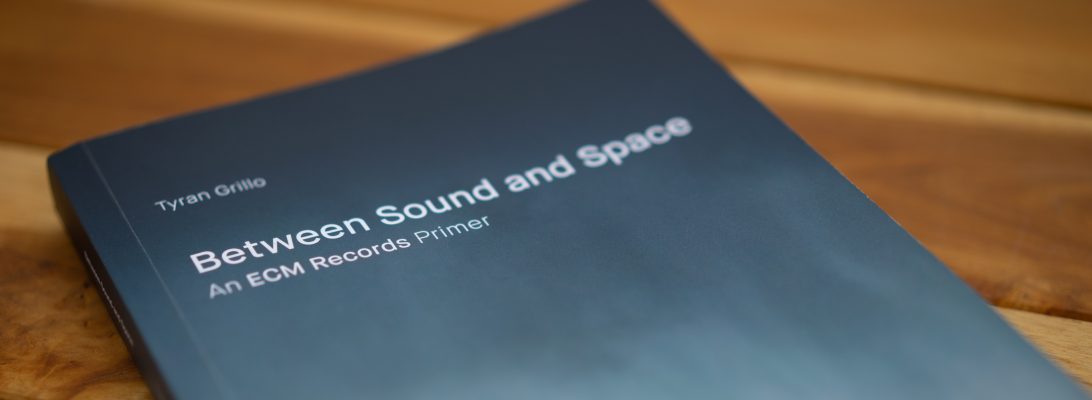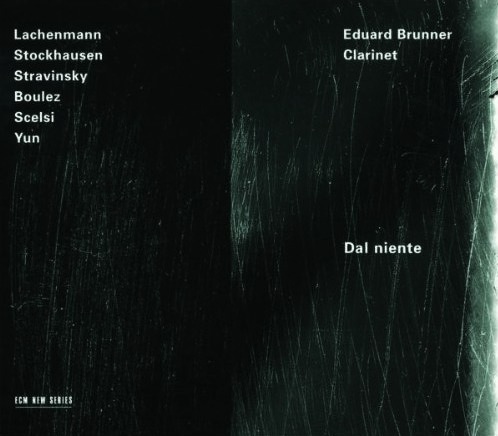Eduard Brunner
Dal niente
Eduard Brunner clarinet
Recorded October 1995, Propstei St. Gerold
Engineer: Peter Laenger
Produced by Manfred Eicher
Swiss clarinetist Eduard Brunner has appeared on such ECM albums as Kurtág’s Hommage à R.Sch. and Kancheli’s Caris Mere. With this fine disc, at last he gives his instrument its due glory in the spotlight, or should I say the shadows. Brunner’s extended technical precision and superb breath control amount to a humble program of contemporary selections that are all about the destination. Virtuosity is merely a means to getting there.
Isang Yun’s Piri is an extended saturnine call. It is as if the clarinet itself takes in and expels its own breath without human assistance. One could hardly ask for a more fitting introduction neither to the album’s sound-world nor to Brunner’s instrumental acuity. A longtime part of his performance repertoire, Piri instigated a friendship between performer and composer that lasted until Yun’s death in 1995. Dark sustained tones lead into flashes of light, which echo through the lofty ceiling of Propstei St. Gerold in nimble footsteps. The piercing quality of long-held notes gets behind the skull and awakens the brain. In those notes are cradled exquisite overtones for the careful ear. The piece’s many glissandi, mocking vocal qualities, and overblowing tell a potent dedicatory tale. As a “prayer” to incarceration (the travails of which Yun was no mere observer), its thread continues to hold strong.
Written for Brunner’s teacher Louis Cahuzac, Igor Stravinsky’s well-regarded Three Pieces for Clarinet Solo introduces some of the instrument’s lower timbers. With these, the music becomes more rhythmically discernible. We begin to feel agitation and weightiness, much in contrast to Yun’s relatively ethereal traumas. Brunner appends to this Stravinsky’s previously unpublished Piece for Clarinet Solo, jotted in the margin of a telegraph in April of 1917 and dedicated to Pablo Picasso.
The highly malleable Domaines pour clarinette seule of Pierre Boulez gives Brunner ample room in which to flex his melodic muscles. Equal parts rest and work, these twelve short pieces thrive in half-breathed reverie.
While Karlheinz Stockhausen’s In Freundschaft exists in versions for many solo instruments, in its present incarnation its birdsong-like qualities are enhanced. This potent dose of sunshine starts off delicately enough, played as if on separate instruments. Every note seems to peek around a corner and scamper before it is found out. A brilliant composition and evocation thereof.
Giacinto Scelsi’s Preghiera per un’ombra gives us another interior monologue. Veiled in its titular shadow and structured by the composer’s enchanting idiosyncrasies, it is suffused with marked changes in emotional climate.
The title of Helmut Lachenmann’s Dal niente (Intérieur III) means “Out of nothing.” And indeed, much of the music consists of forced air with mere hints of notes. Depressed keys plunk like marbles on a frozen lake, while the occasional note screeches above the solace. The sound is downright saxophonic, made all the more so for its metallic undertone. Each breath is different than the last, and shows Brunner’s command even further.
The album is meticulously conceived. The first half is structured around ambulatory bodies, minds, and personalities, while the latter half is more “spiritual” and descriptive. The music wiggles past our expectations, sharing with us its nightmares and fantasies alike. Brunner’s style reminds me very much of Heinz Holliger’s (as a point of reference, his oboe rendition of Piri can be heard on Lauds and Lamentations), for he brings a similar sense of depth and technical attention to his playing. Dal niente sets a challenging bar for contemporary clarinet recordings, one not to be surpassed in the foreseeable future.
<< György Kurtág: Musik für Streichinstrumente (ECM 1598 NS)
>> Jean-Luc Godard: Nouvelle Vague (ECM 1600/01 NS)


